The next bread in the BBA Challenge is #31, New York Deli Rye. I’ve never really been a big fan of rye bread as I mentioned when we made the marbled rye bread a couple of months ago, but that bread made a convert out of me. However, I had my doubts about this bread particularly because the Basic Sourdough Bread didn’t turn out like I had hoped and this sourdough rye bread is made with the same barm.
I decided to give the sourdough another try. I was hoping all it needed was a little more time to develop. Also, I read in the commentary in the book, that adding the caraway seeds to this bread was optional. So, I made it without the caraway seeds to see if I liked the flavor better without them. I did! Yum!
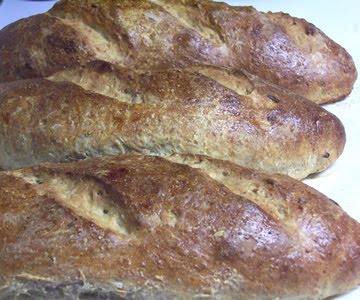
New York Deli Rye Bread
Makes: 3 Loaves
Adapted from: The Bread Baker’s Apprentice by Peter Reinhart
Ingredients:
Rye Sponge Starter
- 1 cup (7 ounces) sourdough starter
- 1 cup (4.5 ounces) whole rye flour
- 1/2 cup (4 ounces) water, lukewarm
- 2 medium (12 ounces) onions, diced
- 2 tablespoons (1 ounce) vegetable oil
Final Dough:
- 3 1/2 cups (16 ounces) unbleached high-gluten, bread, or clear flour
- 1 cup (4.5 ounces) white rye flour
- 2 tablespoons (1 ounce) brown sugar
- 2 1/4 teaspoons (.56 ounce) salt
- 2 teaspoons (.22 ounce) instant yeast
- 2 teaspoons (.22 ounce) caraway seeds (optional)
- 2 tablespoons (1 ounce) vegetable oil
- 1 cup (8 ounces) buttermilk or milk, lukewarm
- 1/4 to 1/2 cup (2 to 4 ounces) water, or as needed, at room temperature
- Semolina flour or cornmeal for dusting
- 1 egg white, whisked until frothy, for egg wash (optional)
Directions:
Making the Starter:
Begin this process the day before you plan to make the bread.
Make the starter by mixing together the barm, rye flour, and water in a small bowl, cover with plastic wrap, and set it aside.
Sauté the onions and let them cool in a bowl until they are warm, not hot. Stir the onions into the starter.
Then re-cover with plastic wrap, and ferment at room temperature until it bubbles and foams, about 3 to 4 hours. Refrigerate overnight. I actually refrigerated it for two nights because of my schedule.

Remove the starter from the refrigerator 1 hour before making the dough to take off the chill.
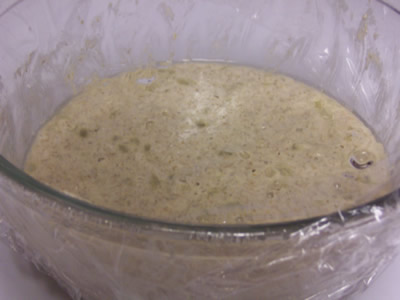
Making the Dough:
Stir together the flours, brown sugar, salt, yeast, and caraway seeds (if using) in a bowl (or use your mixer if you prefer). Add the starter, shortening, and buttermilk.
Stir with a large metal spoon (or with your mixer) until the mixture forms a ball. Add only as much water as is necessary to bring everything together into a soft, not sticky mass. Let this sit for 5 minutes so the gluten can begin to develop.
Transfer the dough to a counter sprinkled with flour and knead the dough for no more than 6 minutes if possible. This is to prevent the dough from getting gummy. Only add enough flour to make a firm, slightly tacky dough.
Fermenting the Dough
Lightly oil a large bowl and transfer the dough to the bowl, rolling it around to coat it with oil. Cover the bowl with plastic wrap. Ferment at room temperature for 1 1/2 to 2 hours or until the dough doubles in size. It took mine longer than 2 hours because my kitchen was cold the day I made this bread.

Remove the dough from the bowl and divide it into 2 or 3 equal pieces.
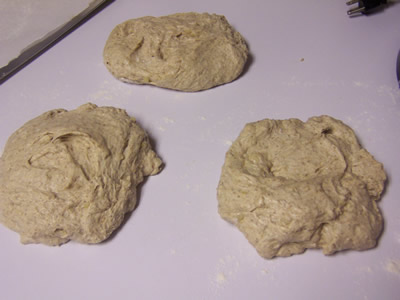
Shaping the Loaves
I decided to shape them into batards because I think that shape is so cool.
To make the batards, gently pat the dough into a rough rectangle.
Without degassing the piece of dough, fold the bottom third of dough, letter style, up to the center and press to seal, creating surface tension on the outer edge.
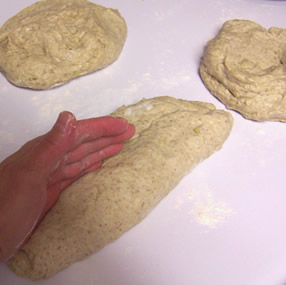
Fold the remaining dough over the top and use the edge of your hand to seal the seam closed and to increase the surface tension all over. Set them aside for proofing.
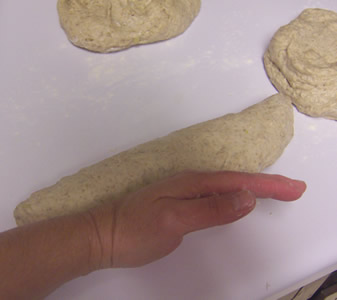
Proofing the Loaves
Line a baking sheet with parchment paper and dusted it with cornmeal. Then transfer the loaves to the baking sheet and mist the tops of the loaves with baking spray. Proof the loaves at room temperature for approximately 90 minutes, or until they have grown 1 1/2 times in size.
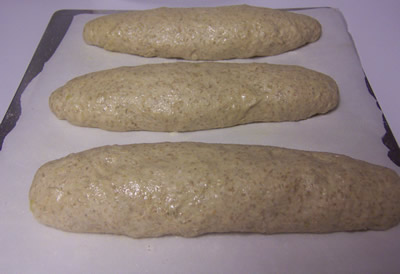
Baking the Loaves
Preheat the oven to 400 for the free-standing loaves. Brush the loaves with egg wash.

Scoring them is optional but I decided to do it and I’m glad I did. I actually used my lame this time and it worked pretty well. Maybe I’m getting the hang of it after all.
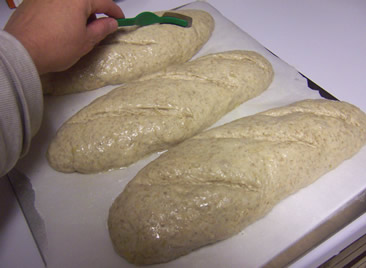
Bake the loaves for 20 minutes, then rotate the pans 180 degrees for even baking, and continue to bake for 15 to 40 minutes, depending on the size and shape of the loaves. The loaves should be golden brown all over and make a hollow sound when thumped on the bottom.
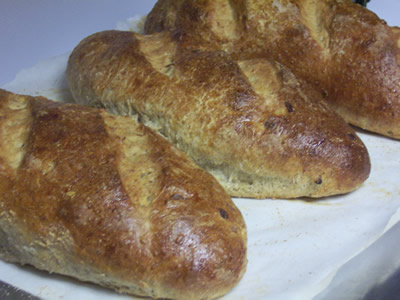
Remove the loaves from the oven, then transfer them to a wire rack to cool for at least 1 hour before slicing or serving.
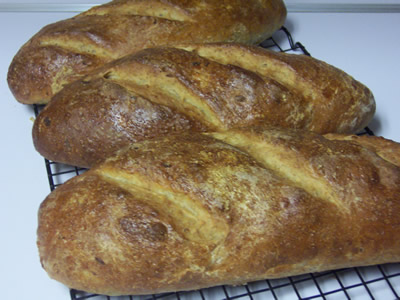
I liked these loaves so much I submitted them to YeastSpotting, a weekly bread roundup hosted by Susan of Wild Yeast. Please visit Wild Yeast to view all of the lovely breads in the roundup.
I brought a loaf over to some friends house for dinner the other night and they loved it too!
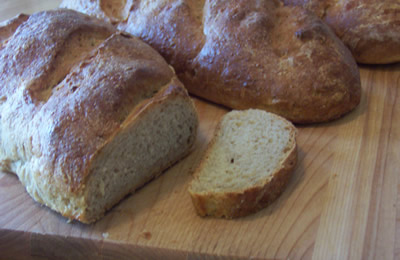
I’ve had this bread with homemade black bean chili, tomato soup, roast and potatoes, toasted with jam and just plain with butter. Yummy! Yummy! At that time of this post, I only have one loaf left. Sigh!
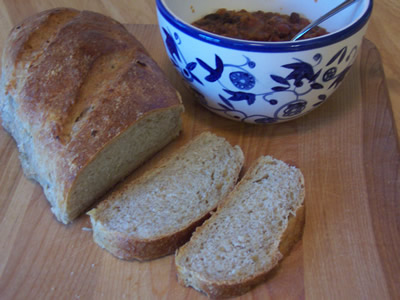
Happy Baking!
Cathy
Cristie says
Beautiful loaves. I need to make some rye bread. I have the flour, but haven’t tried it yet. Your pictures are so helpful, thanks for going to the extra effort!
Cathy (breadexperience) says
Thanks Cristie! I live these rye loaves. The flavor and texture is wonderful!
Ezzie says
Wonderful documentation…they look delicious…ah if only we had smell-a-vision! I add pickle juice to my NY deli rye. Comes out so good. I’ll have to try the batard shape!
Cathy (breadexperience) says
Smell-a-vision! Now there’s an idea! Pickle juice sounds wonderful. I’ll have to try that!
gaaarp says
Nice job! I’m glad to hear you’ve become a rye convert. Just wait until you get to the Swedish Rye (Limpa). You’ll plotz, it’s so good.
Cathy (breadexperience) says
Thanks Phyl! I’m looking forward to making the Limpa. Sounds interesting.
Rosemary & Garlic says
Cathy, those look delicious. I thought that the next bread, the 100% sourdough rye bread was the worst bread I have ever made. Not to discourage you.
Anne Marie
Cathy (breadexperience) says
Ann Marie, Thanks for the heads up! I might make the next bread with Spelt since that is one of the options. We’ll see if I like that better.
Urban Breadmachine says
I never realized their was suppose to be onions in rye bread… sure sounds tasty though!
Cathy (breadexperience) says
Urban Breadmachine! I like that name. I see you’re also in Atlanta. Thanks for stopping by.
Some rye breads do include onions, but not all.
Mary says
Cathy, your loaves look wonderful. You’ve done a nice job with them. I love rye bread and wish I could have a slice of yours. Kudos..
Cathy (breadexperience) says
Thanks Mary!
Mags says
Your loaves look fantastic! I’m really looking forward to making this one.
Cathy (breadexperience) says
Thanks Mags! They tasted wonderful as well! You’ll like them.
Michelle says
OH we love Rye Bread and I’ve not made it in quite a while now!
I do have a sandwich in mind though!!
Cathy (breadexperience) says
Yes, these make great sandwich loaves!
Annarasa says
These look so good. I can see them as a great sandwich!!
Cathy (breadexperience) says
Thanks Annarasa! They would make a great sandwich!
Christine says
Thanks for sharing your experience! I have the book and noticed a discrepancy. Your version of the recipe calls for 1 cup WHOLE rye in the sponge whereas the original has 1 cup “white (aka light) rye flour”. Won’t yours produce a stronger tasting and slightly heavier loaf? Whole rye is also called dark rye. Not the same as light rye.
Cathy says
I did use 1 cup whole rye in the sponge instead of light rye but it didn’t make the bread dense because it has 3 1/2 cups of white flour in the final dough.
It’s been a while since I’ve made this bread, but I do remember that I liked it. I’m not a big rye fan but this one had good flavor and texture.
That being said, it’s up to you whether you want to use any whole grain rye or to stick with the light rye in the sponge and the final dough as the original formula indicates.